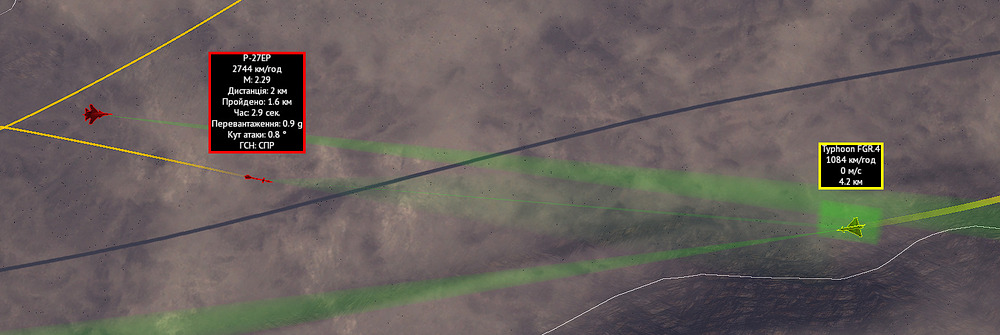At those kinds of speeds and heights (against something at “normal” height) Id actually expect very very good LSZs.
yeah but at the same tiime it shouldnt be more than say 30km, 60 km lsz is like meteor territory
But at what height?
Very high and fast fired at something down low is gunna have a very large LSZ.
Meteor is a monster because it has a large LSZ when firing at something at equal height. So isnt gaining energy in the dive.
I’ll do some matches with the Aim-120A/B and see if I can get the LSZs to bug. But the LSZ by definition shouldnt be larger than the rMax.
no necessarily due to the increasing air density the drag increases
and that would be problematic with the ram jet because it needs high speeds to function
I’ve now been able to play a few matches with the new Eurofighter radar, and I have to say that right now it’s a radar that gets the job done — nothing more.
And for what is supposed to be one of the best mechanical radars in the game, it’s still very mid. It does its job like the American radars on the F-16, F-15, and F-18, and other top tier jets. But it’s nothing spectacular or anything, considering it should be one of the most advanced mechanical radars in the game. 😐😑
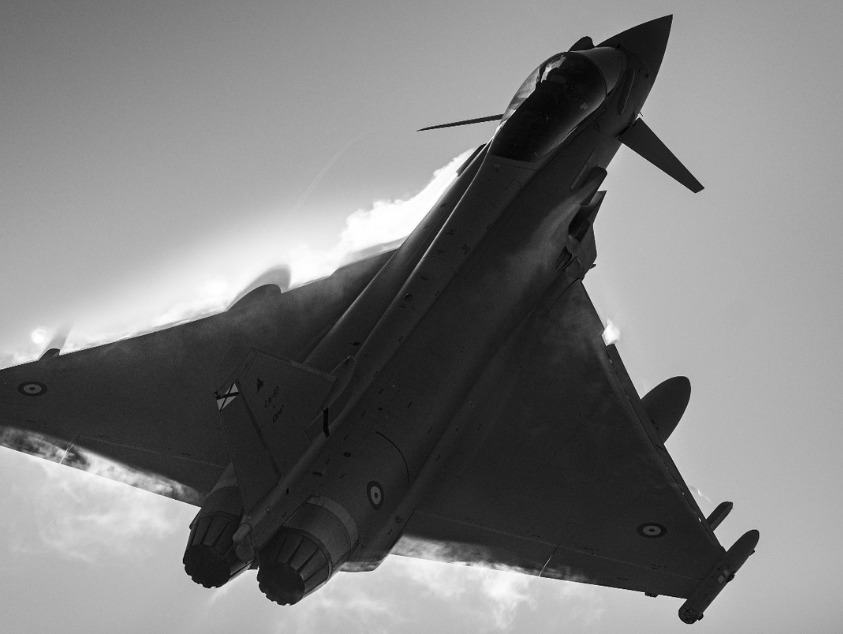
So far, so good on the ghosting front. Ive not noticed any yet that cant be explained by the TWS being slightly delayed in update
Massive change in every game mode I am no longer stumbling blindly into Su-30s that my Radar couldn’t see I feel confident enough to press advantages. It’s so nice taking off and seeing the Radar near instantly find something. The ACM mode is perfect and the IRST is extremely useful for finding hovering helis and locking them for a Brimstone shot.
The ground mode wow what a difference you can now see those pesky campers and flankers it’s a huge QOL improvement and I have to say well done Gaijin!
so apparently if you launch a brimstone and paveway at the same time you can just explode.
![]()
Also brimstones seem to just go ballistic now. I think that’s a bug.
Adding to this i’ve played a few matches… The HMD is so responsive. I havent found myself fiddling with it trying to get it to lock a jet that’s right there (in fact it’s locked aircraft that i in my infinite wisdom didnt even put the acquisition square on)
Yasser moment
Yeah. Im gunna say something isnt right here
:D
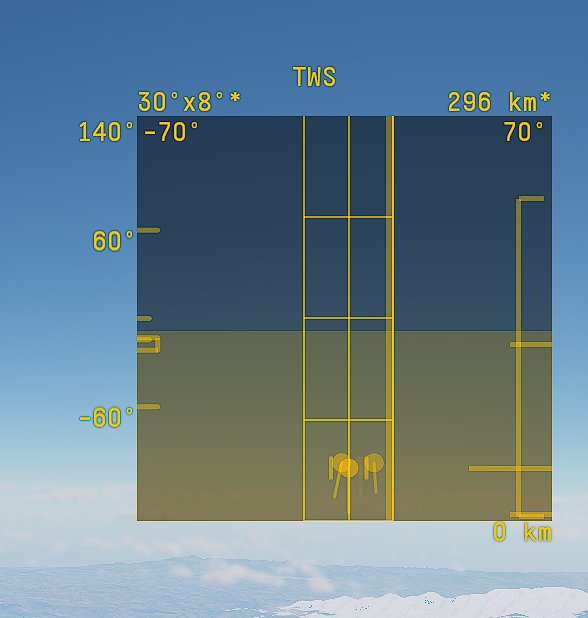
That’s one big LSZ, and it was getting bigger
Didn’t know the eurofighter was equipped with trident II…
Update on the weird MAW responses. I took a look in the code for the EF.
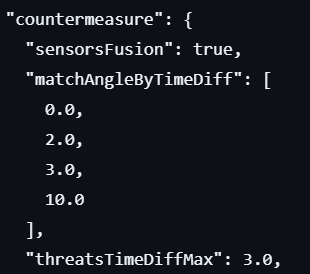
Starts with this weird section. This is probably responsible for matching weapons to RWR signals and is probably the reason it fails to identify SARH sometimes.
It then appears to check if the existing signals passed from MLWS and RWR within this angle of eachother (interestingly not LWR) are active to figure out the threat type.
Then there’s the code for the response which, in order:
1: In response to SACLOS: do nothing??? feels redundant.
2: In response to a Track+SACLOS, SARH, or ARH missile and IR missile in the same region: Launch flare+chaff in pairs
3: In response to Track+SACLOS, SARH, or ARH missile alone: launch chaff individually
4: In response to IR alone: Launch flares in groups of 4
5: In response to SARH: Launch flares and chaff in groups of 4
I think i’ve only ever seen responses 3 and 4 ever happen. Will do further testing to see what conditions are needed to trigger the rest (except the SACLOS one. I don’t know why that’s there really.)
Quick preliminary very very unprofessional test to see what I can find out about it:
Launch 1: R-27ER, 12km directly abeam
Threat detected at 8km. Angle difference from radar to threat 2-3 degrees. Triggered response 5, swapped to response 4 after one burst as angle difference increased.
Launch 2: R-27ER, 3km like roughly nose on.
Threat detected at 2km. Angle difference of roughly 4-5 degrees. Triggered response 4 exclusively.
Launch 3: R-27ER, 8km rear aspect.
Threat detected at 7km. Angle difference negligible (like 1 degree)
This launch is the most interesting one and i’m going to have to check this a lot further (see below), because despite a constant missile alert from 7km to impact, the countermeasures were intermittent (and only flares when they did work). This suggests it’s swapping between identifying the incoming missile as SACLOS and IR, but failing to identify it as SARH even once.
This is incredibly weird, as as shown here:
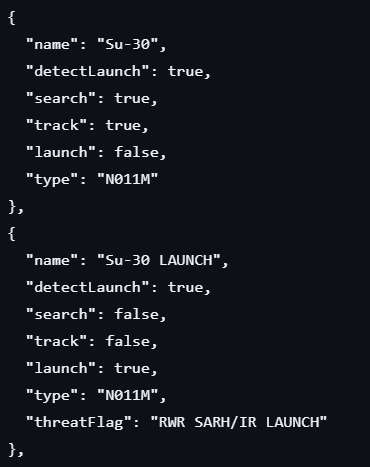
an Su-30 launch signal should flag up as SARH. RWR SACLOS flags are only triggered from certain launchers such as 2S6 or Pantsir, and a SACLOS launch with a track should result in chaff being deployed.
My current running theory is this, and the following is speculation:
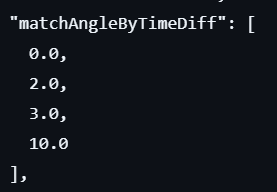
This may be what decides whether the threat is SACLOS, radar, or IR when combined with a radar track (or whether the track is totally unrelated). From these three launches alone, it’s visible that the “0-2” band appears to be treated as SACLOS (Which would make sense, as SACLOS missiles will follow a line between the launcher and target), while the 2-3 band is treated as SARH and the 3-10 band as IR.
![]()
This then likely sets the maximum for correlation to 3 degrees, which would make the IR+radar redundant. I cannot test this as it is literally just treated as IR, so its totally pointless in the first place (see below)
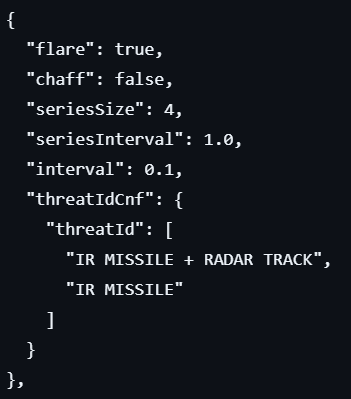
This would explain why the matchAngleByTimeDiff array has four values, instead of only having one maximum. It would also explain the behaviours in this initial test, and why the SARH response is so abysmally rare even when the missile is within the necessary angle, as this may just trigger it to not respond at all.
The concern is that if this is true, that means the angle gates, which are much less reliable than the sensor fusion, are overriding the actual sensor fusion.
An alternative would be that the threat flags have an unintentional heirarchy in their order, which would also explain SACLOS overriding under certain conditions as it is at the top of the list.
I don’t think additional testing will actually help here. There are no additional conditions which would provide valuable info (unless someone has suggestions lol). This reads as spaghetti code messing with the DASS behaviour. Will put together a report when its not 4am. (done) → Community Bug Reporting System tada
Quick further one I thought of: Tested against SA-2 (S-75). This is a true SACLOS weapon, and therefore triggers the actual SACLOS responses. Two tests were done: one headon to the threat (providing a consistent angle) and one while almost abeam (not notching, but making the angle between radar and missile inconsistent.). When headon, there was no response whatsoever. This matches the result with the Su-30 - when angle between launcher and missile is negligible it appears to not respond at all. When at an angle, the response was flares only. This is again consistent, as the threat is not SARH and therefore the response was simply IR, even though I was being locked.
TL;DR it works brilliantly vs IR/ARH and is near useless at correctly responding to anything else.
After new radar changes EFT became much better than before.
People consistently getting more kills in GRB than ever before.
Man i love it, our EFT’s finally got closer to Rafale in terms of radar performance, now all we need is either limited F&F Brimstones or Brimstone2/Spear 3.
I mentioned it earlier but I feel like all the brimstone F&F concerns could be solved by just making it cost a fortune in SP per missile so if you want 18 brimstones you’re basically just buying a nuke and at that point play the nuke.
Or they can just remove ignoring smoke abilities and LOAL, this will make them more balanced but 18 missiles is still an issue in the end.
I mean it cannot be that difficult to implement it the same as spikes and then just give the modern smoke dischargers a radar signature.
Cant wait for the brimstones to be going for smokes deployed by some german main at the edge of the map instead of the spaa you fired at lol.




